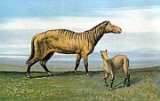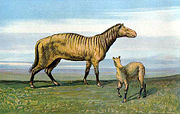
Orohippus
Encyclopedia
Orohippus is an extinct ancestor of the modern horse
that lived in the Eocene
(about 50 million years ago).

 It is believed to have evolved
It is believed to have evolved
from palaeotheres such as Hyracotherium
, as the earliest evidence for Orohippus appears about 2 million years after the first appearance of Hyracotherium. The anatomical differences between the two are slight: they were the same size, but Orohippus had a slimmer body, a more elongated head, slimmer forelimbs and longer hind legs, all of which are characteristics of a good jumper. The upper premolar
s of Orohippus are more molariform (flat-surfaced) than in Hyracotherium, giving Orohippus more teeth for grinding, and the crests on the teeth are more pronounced, indicating that Orohippus probably fed on tougher plants. The outer toes of Hyracotherium are no longer present in Orohippus, hence on each forelimb there were four fingers (toes) and on each hind leg three toes.
Orohippus has also been referred to as Protorohippus.
Horse
The horse is one of two extant subspecies of Equus ferus, or the wild horse. It is a single-hooved mammal belonging to the taxonomic family Equidae. The horse has evolved over the past 45 to 55 million years from a small multi-toed creature into the large, single-toed animal of today...
that lived in the Eocene
Eocene
The Eocene Epoch, lasting from about 56 to 34 million years ago , is a major division of the geologic timescale and the second epoch of the Paleogene Period in the Cenozoic Era. The Eocene spans the time from the end of the Palaeocene Epoch to the beginning of the Oligocene Epoch. The start of the...
(about 50 million years ago).


Evolution
Evolution is any change across successive generations in the heritable characteristics of biological populations. Evolutionary processes give rise to diversity at every level of biological organisation, including species, individual organisms and molecules such as DNA and proteins.Life on Earth...
from palaeotheres such as Hyracotherium
Hyracotherium
Hyracotherium , also known as Eohippus or the dawn horse, is an extinct genus of very small perissodactyl ungulates that lived in the woodlands of the northern hemisphere, with species ranging throughout Asia, Europe, and North America during the early Tertiary Period and the early to mid Eocene...
, as the earliest evidence for Orohippus appears about 2 million years after the first appearance of Hyracotherium. The anatomical differences between the two are slight: they were the same size, but Orohippus had a slimmer body, a more elongated head, slimmer forelimbs and longer hind legs, all of which are characteristics of a good jumper. The upper premolar
Premolar
The premolar teeth or bicuspids are transitional teeth located between the canine and molar teeth. In humans, there are two premolars per quadrant, making eight premolars total in the mouth. They have at least two cusps. Premolars can be considered as a 'transitional tooth' during chewing, or...
s of Orohippus are more molariform (flat-surfaced) than in Hyracotherium, giving Orohippus more teeth for grinding, and the crests on the teeth are more pronounced, indicating that Orohippus probably fed on tougher plants. The outer toes of Hyracotherium are no longer present in Orohippus, hence on each forelimb there were four fingers (toes) and on each hind leg three toes.
Orohippus has also been referred to as Protorohippus.

